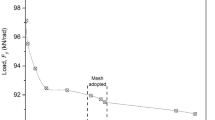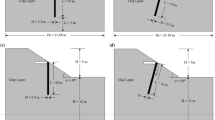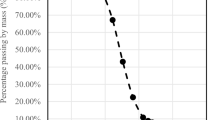Abstract
Soil arching occurs when differential movement develops. In geosynthetic-reinforced pile-supported embankments, soil arching occurs when the geosynthetic deflects in the area between the piles. Due to the soil arching, a relatively large part of the load (A) is transferred towards the piles directly, which reduces the residual load part (B) exerted on the geosynthetic reinforcement between the piles. This paper presents the results of experiments in a two-dimensional test set-up with analogical soil. The results of the experiments are analysed using analytical calculations. The set-up of tests was designed in a way that it was especially suitable for measuring these two load parts A and B separately. In this research, it was assumed that the subsoil between the piles was so soft that support of subsoil (load part C) is zero. Comparison of analytical calculations and tests just before rupture of the reinforcement showed that the fill height strongly affects the soil arching. For high fills, the vertical load concentrates on the reinforcement closer to the beams, effectively a more or less inverse-triangular load distribution. For relatively thin embankments, the load resembles more a uniform or triangular load distribution. The inverse-triangular load distribution in the higher embankments results in a steeper slope of the reinforcement at the edge of the beam. This makes the reinforcement more effective, so that more load can be transferred through the same reinforcement without rupture.






















Similar content being viewed by others
Data Availability
The datasets generated during and/or analysed during the current study are available from the corresponding author on reasonable request.
Code Availability
Not applicable.
Notes
Rmax (L = 0.2 mm) = 12.5 μm [20].
References
van Eekelen SJM, Han J (2020) Geosynthetic-reinforced pile-supported embankments: state of the art. Geosynth Int 27(2):112–141. https://doi.org/10.1680/jgein.20.00005
van Eekelen SJM (2015) Basal reinforced piled embankments. Ph.D. thesis, Delft University of Technology, Delft, the Netherlands. http://repository.tudelft.nl/view/ir/uuid%3A492dc4f3-9345-439e-9268-7c27c57e110b/
Terzaghi K (1936) Stress distribution in dry and in saturated sand above a yielding trap-door. Massachusetts 307–311.
Feng SJ, Ai SG, Chen HX (2017) Estimation of arching effect in geosynthetic-reinforced structures. Comput Geotech 87:188–197. https://doi.org/10.1016/j.compgeo.2017.02.014
Liu W, Qu S, Zhang H, Nie Z (2017) An integrated method for analyzing load transfer in geosynthetic-reinforced and pile-supported embankment. KSCE J Civ Eng 21(3):687–702. https://doi.org/10.1007/s12205-016-0605-3
van der Peet TC, van Eekelen SJM (2014) 3D numerical analysis of basal reinforced piled embankments. In: Tenth international conference on geosynthetics, pp 21–25
Le Hello B, Villard P (2009) Embankments reinforced by piles and geosynthetics—numerical and experimental studies dealing with the transfer of load on the soil embankment. Eng Geol 106(1–2):78–91. https://doi.org/10.1016/j.enggeo.2009.03.001
Zaeske D (2001) Zur Wirkungsweise von unbewehrten und bewehrten mineralischen tragschichten über pfahlartigen gründungselementen. Ph.D. Thesis, Schriftenreihe Geotechnik, Universität Gh Kassel, Kassel, Germany. Heft 10 (in German).
Yun-Min C, Wei-Ping C, Ren-Peng C (2008) An experimental investigation of soil arching within basal reinforced and unreinforced piled embankments. Geotext Geomembr 26(2):164–174. https://doi.org/10.1016/j.geotexmem.2007.05.004
Jenck O, Dias D, Kastner R (2009) Discrete element modelling of a granular platform supported by piles in soft soil–Validation on a small scale model test and comparison to a numerical analysis in a continuum. Comput Geotech 36(6):917–927. https://doi.org/10.1016/j.compgeo.2009.02.001
Briançon L, Simon B (2012) Performance of pile-supported embankment over soft soil: full-scale experiment. J Geotech Geoenviron Eng 138:551–561. https://doi.org/10.1061/(ASCE)GT.1943-5606.0000561
Rui R, Ye Y, Han J, Zhai Y, Wan Y, Chen C, Zhang L (2022) Two-dimensional soil arching evolution in geosynthetic-reinforced pile-supported embankments over voids. Geotext Geomembr 50(1):82–98. https://doi.org/10.1016/j.geotexmem.2021.09.003
Lai HJ, Zheng JJ, Zhang J, Zhang RJ, Cui L (2014) DEM Analysis of ‘soil’-arching within geogrid-reinforced and unreinforced pile-supported embankments. Comput Geotech 61:13–23. https://doi.org/10.1016/j.compgeo.2014.04.007
Rui R, Han J, van Eekelen SJM, Wan Y (2019) Experimental investigation of soil-arching development in unreinforced and geosynthetic-reinforced pile-supported embankments. J Geotech Geoenviron Eng 145:1–11. https://doi.org/10.1061/(ASCE)GT.1943-5606.0002000
Fagundes D, Almeida M, Thorel L, Blanc M (2017) Load transfer mechanism and deformation of reinforced piled embankments. Geotext Geomembr 45(2):1–10. https://doi.org/10.1016/j.geotexmem.2016.11.002
Jenck O, Dias D, Kastner R (2005) Soft ground improvement by vertical rigid piles two-dimensional physical modelling and comparison with current design methods. Soils Found 45:15–30. https://doi.org/10.3208/sandf.45.15
van Eekelen SJM, Bezuijen A, Lodder HJ, van Tol AF (2012) Model experiments on piled embankments. part I. Geotext Geomembr 32:69–81. https://doi.org/10.1016/j.geotexmem.2011.11.002
van-Eekelen SJM (2016) The 2016-update of the Dutch design guideline for basal reinforced piled embankments. Procedia Eng 143:582–589. https://doi.org/10.1016/j.proeng.2016.06.077
EBGO (2010) Empfehlungen für den Entwurf und die Berechnung von Erdkörpern mit Bewehrungen aus Geokunststoffen e EBGEO, vol. 2, 978-3-433-02950-3. Also available in English: Recommendations for Design and Analysis of Earth Structures using Geosynthetic Reinforcements e EBGEO, 2011. ISBN 978-3-433-02983-1 and digital in English ISBN 978-3-433-60093-1
Kishida H, Uesugi M (1987) Tests of the interface between sand and steel in the simple shear apparatus. Geotechnique 37(1):45–52
van Eekelen SJM, Lodder HJ, & Bezuijen A (2011) Load distribution on the geosynthetic reinforcement within a piled embankment. In: Proceedings of the 15th European conference on soil mechanics and geotechnical engineering. IOS Press, pp 1137–1142
van Eekelen SJM, Bezuijen A, Lodder HJ, van Tol AF (2012) Model experiments on piled embankments. Part II. Geotext Geomembr 32:82–94
Funding
This research did not receive any specific grant from funding agencies in the public, commercial, or not-for-profit sectors.
Author information
Authors and Affiliations
Contributions
MFN: making a model of the test device; performing the experiments; analyzing the results and writing the preliminary text of the article. SHL & AN: conceived and designed the experiments; checked the results of the tests; made improvement in interpretations. SJMvE: help in achieving analytical results according to the two-dimensional model of the tests; help in interpreting test results; review and final approval of tests; help in preparation of geosynthetic materials; help in determining the characteristics of geosynthetic materials to perform analysis; help in final review of the figures. Finally, SHL, SJMvE and AN read the manuscript.
Corresponding author
Ethics declarations
Conflict of Interest
The authors declare no conflict of interest.
Additional information
Publisher's Note
Springer Nature remains neutral with regard to jurisdictional claims in published maps and institutional affiliations.
Rights and permissions
Springer Nature or its licensor (e.g. a society or other partner) holds exclusive rights to this article under a publishing agreement with the author(s) or other rightsholder(s); author self-archiving of the accepted manuscript version of this article is solely governed by the terms of such publishing agreement and applicable law.
About this article
Cite this article
Fakhrian Nejad, M., Lajevardi, S.H., van Eekelen, S.J.M. et al. Two-Dimensional Experimental and Analytical Investigations of Load Distribution on Piled Embankments. Int. J. of Geosynth. and Ground Eng. 8, 72 (2022). https://doi.org/10.1007/s40891-022-00415-w
Received:
Accepted:
Published:
DOI: https://doi.org/10.1007/s40891-022-00415-w




